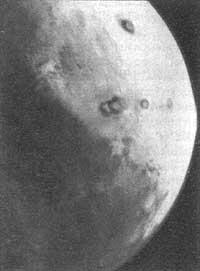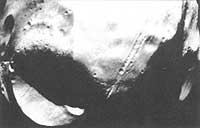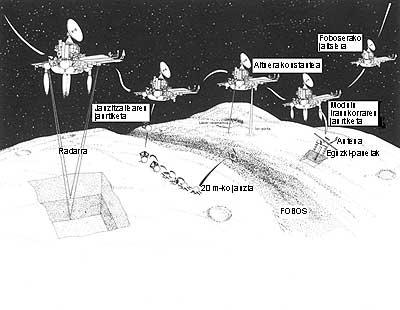Fobos, shield of Martitz

From the very moment the exploration of space was born 30 years ago, Martitz has been recognized as a researcher. In the beginning, the main objective of the missions was to know whether there is life on Mars or not, but as the Viking probes found no trace of life, the most attractive objective of today is for humans to leave. Without forgetting this main objective, we cannot forget the knowledge of Martitz himself and the lights that this knowledge can bring about the origin of the Solar System.
Next July two Soviet probes leave the Earth and head to Mars. These probes, called fobos, have explored the Mars Phobos satellite. In the opinion of many, this mission will be the most representative of the space explorations that will take place in the coming years. On the one hand, because it is considered that direct information can be obtained on the origin of the Solar System and on the other, because some infrastructure systems (communications and navigation systems, for example) necessary for the takeoff of the human being will be demonstrated.
Fobos is the largest of the two satellites on Mars and the orbit closest to Mars. Its origin and structure arouses great interest among astronomers. The Fobos mission will conduct a comprehensive and comprehensive analysis of the satellite.
Why Fobos?
When it comes to proposing the mission to Mars you can think that the most interesting thing is to explore the planet itself in the first blow. However, if the problem is analyzed more slowly, it is perceived that there are founded reasons for the exploration of Phobos.
Until the American Viking probes passed around the satellite, little was known about the Mars satellite. The photographs sent by the probes have been very interesting and have increased the curiosity of scientists.
The surface of the phobes is full of parallel cracks 20-30 meters deep and 400-600 meters long. In addition, at one end, elliptically, is a huge impact crater of 8 km in diameter, Fobos 27 km in diameter. What kind of impact did this geological structure create?
On the other hand, the density of Phobos (2.0 g/cm 3) is very low compared to that of the Earth (5.52 g/cm 3) or that of Mars (3.93 g/cm 3). This indicates that Fobos, like the Earth, is not made up of compact stones transformed by vulcanism. Fobos is made up of other stones. Fobos has a density similar to meteorites called carbonated condrites. In addition, in sessions of reflective spectrometry on its surface results have been obtained similar to those obtained with the condrites.
This can be very important because many astronomers believe that carbonated condrites witness the creation of the Solar System. Therefore, if Fobos were condrite, his exploration could give us new clues to better understand the conditions and mechanisms existing at the time of the creation of our planetary system and, at the same time, to know the necessary conditions to create similar systems in other stars.
In addition to this, the surface of Fobos has another special feature: it is covered with regolite powder and has no remains of meteorite impact craters. The latter does not match the one you could expect. Space bodies without atomosphere like the Moon are covered with impact craters.
Therefore, Fobos has something to do with and analyze.
However, the missions of Fobos will also analyze Martitz himself. Other studies will study the presence of water remains in the atmosphere of Mars.
Characteristics of Fobos missions
As already indicated, at the beginning of next month and with a difference of a few days, two Proton launchers will be launched from the Baiconur cosmodrome and will carry at their ends an automatic Phobe probe. The two phobe probes will be identical and each will carry 22 sessions in 12 different villages. These sessions will investigate the Sun, Martitz and Fobos.
Two different probes are emitted to ensure the success of the mission. If someone had any unforeseen events along the way, the other could complete the mission.
About two hundred days after the launch of the Fobos probes will reach the Martitz area. Then, they will take the elliptical orbit and initiate a complicated and careful maneuver of approach to the Fobos. This first orbit will be very eccentric. The furthest point is 79,000 km from Mars and the nearest point is 500 km.
When this orbit is well placed, the probe is moved to the second elliptical transfer orbit. Its furthest point is 79.000 km and the nearest one is 9.700 km (322 meters above the orbit of Fobos).
In the third maneuver the elliptical orbit is transformed into a circular orbit of 9,700 km radius.
Subsequently, once the parameters of the orbit are accurately secured, a new maneuver will begin to synchronize the movement of Phobos and the probe.
At that moment the gravitational pull of Fobos begins to work. The probe will begin to gently fall to the ground at a speed of 2-5 km/h. At a height of about fifty meters, it stabilizes with some engines and flies about twenty minutes. Meanwhile, the other probe will pass 1000 km from the surface of Mars.
If all goes well, the Soviets will then direct the probe to Deimos, the second satellite on Mars.
You can think that such maneuvers are very difficult and complex. It can be compared with what makes a sunflower in a trapezium. Use powerful and high-level computers, calculators, data transmission media, navigation systems and treektographies to successfully complete the work. So Soviet science and technology will face a great challenge.
New technology
The Soviets have made great effort and work in the mission of Fobos. The design of the Fobos probes is completely new and exceeds the design of the previous interplanetary probes. Controlled by a central computer, it incorporates new economic engines for orbital maneuvers.

Probe orientation is a major problem. Antennas and tests should be very oriented towards the Sun, Earth, Mars and its satellites. The orientation will take as reference the Sun and the Canopus star and the precision will be of a degree in the three axes of space. In addition, if the astronomical orientation is not enough, the probe has a gyroscopic platform connected to two accelerometers.
The information emitted by the probes will be collected on the ground using a 64-70 m antenna system. The tracking antennas will be five distributed worldwide: Ussuriisk (by the Ussuri River), Jevpartoria (in the Crime), Goldstone, Madrid and Camberra. The maximum speed of ground communications will be 4 kilobit/s and if the Earth was never visible, the accumulated information would be stored in a memory of 30.106 bits.
Special tests
22 will be the trials of Phobos. Two of them, Lima D and Dion, are very special. It is about analyzing the isotopic composition of the soil of Fobos.
Lima D is the first ever made of its kind. When the probe flies at a distance of 50 m from the ground, by a laser the materials that form the surface of the soil will evaporate and ionize. The ionized gas generated will be collected and analyzed by a mass spectrometer located in the probe. Due to the prediction, during the tour the laser will be fired at a distance of 10-13 meters.
In the Dion program, the soil of Fobos will be bombarded with ions of crypts. These ions will extract other ions from the soil and be studied. The nature of these extracted ions indicates the substances that form the outer layer of Phobos.
On the other hand, the three video cameras that will work on different channels will offer us color images of Phobos with a resolution of a few centimeters. In addition, thanks to rotating mirrors, you can get the views of Fobos with stars in the background. This data will be of great use to solve some navigation problems and also
Also to study the movement of rotation and precesion of phobes. The depth structure of the satellite floor will also be analyzed. To do this, a radio frequency survey (5, 130 and 500 MHz) will be carried out up to a depth of 200 meters. These measurements will be complemented with others that will be made between 0.3 and 50 microns. These sessions let you know if the Fobos condrite is carbonated.
Anchoring

Not all sessions held in Fobos will be at a distance. Fobos will release two automatic modules, which will fobe. One of them will firmly join the satellite via an anchor. With solar panels you will get the energy you need and it is expected to work for a long time. This module must perform large tasks.
Among astronomers the known phenomenon is that Fobos is slowly approaching Mars. This approach is due to the acceleration in the movement of the satellite. By coinciding the module with the satellite, the measurement of the positions of the Sun and the stars at different times allows to know the exact magnitude of this acceleration and, therefore, the current and original route of Fobos.
This same module will analyze the soil components using alpha ray spectrometry and x-ray fluorescence. The scientific team of the module consists of a thermometer and a television camera.
The second module that will release the probe will have the same scientific instrumentation as the first, but the difference is evident between both: this will be mobile and will analyze the surface of Fobos in different places. Thanks to some ducks will make jumps of 20 m. This module will provide information on the characteristics of the satellite floor in different places.
Martitz orbiting
The work of both probes will not end with the exploration of Phobos. Once the work is done on the satellite, they will be placed in orbit around the planet at a height of 500 km. In this situation the probes will start new sessions. Among other things, the pressure profiles and the magnetic field of distribution of the different gases present in the atmosphere of Mars (carbon dioxide, ozone and water vapor, among others) will be analyzed.
*
After all we have seen, the work of the Soviet Fobos probes cannot deny that it is very ambitious. The data that will be obtained in this mission can serve to reinforce our ideas about the origin of our system. But, according to the new data, it would not be surprising to have to make new changes. We will also see Martitz himself differently, as happened after receiving data from the Viking probes. In any case, Martitz will be closer. The colonies of Martitz, which may be the first step of the trip to the stars, could be in the street canton in a few years.
Chronicle of exploration in Martitz1960
1962
1964
1969
1971
1973
1975
1988
1992
1998
2010
|
Martitz satellites Martitz has two satellites: Fobos and Deimos. These two are, if necessary, the most surprising objects of the solar system. Due to their small size, they were not discovered until 1877. The moon furthest from the surface of the planet is Deimos and is 23,000 km from the center of Mars. Fobos, however, is very close to the surface, 9.300 km from the center. Deimos and Fobos are characters of Greek mythology that mean terror and fear in Greek respectively. The two were two of the four hidden from the god of war, Ares. There are many hypotheses about the origin of these two satellites. Most astronomers believe that both are two asteroids caught when Martitz was formed. However, other curious and surprising hypotheses have been formulated. One of them says that both are two artificial satellites put in the air by very advanced civilizations. The basis of this hypothesis is found in some anomalies in the size of the satellites, which are the smallest in the solar system, and in their movement. In addition, both would be empty inside to explain their low density. However, the external appearance of both satellites is very different. Both are ellipsoid shaped and the main axis of the ellipsoid is perpendicular to Mars. However, while the surface of Deimos is smooth and diffuse, the surface of Fobos is full of impact craters, with the same appearance as the surface affected by smallpox. Characteristics of Martitz satellites |
Buletina
Bidali zure helbide elektronikoa eta jaso asteroko buletina zure sarrera-ontzian












